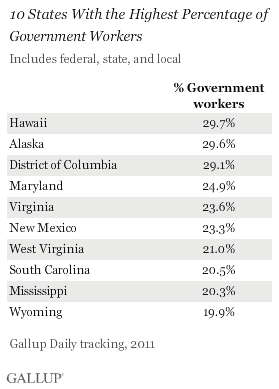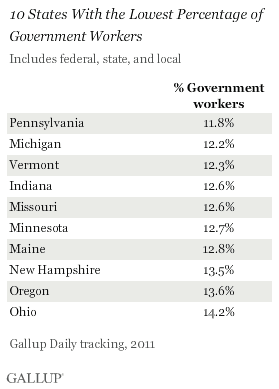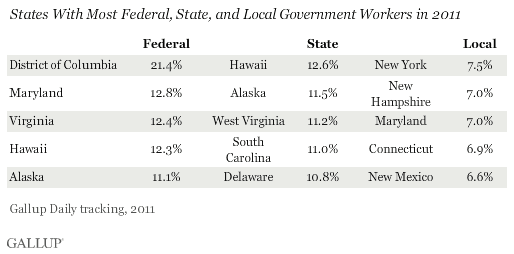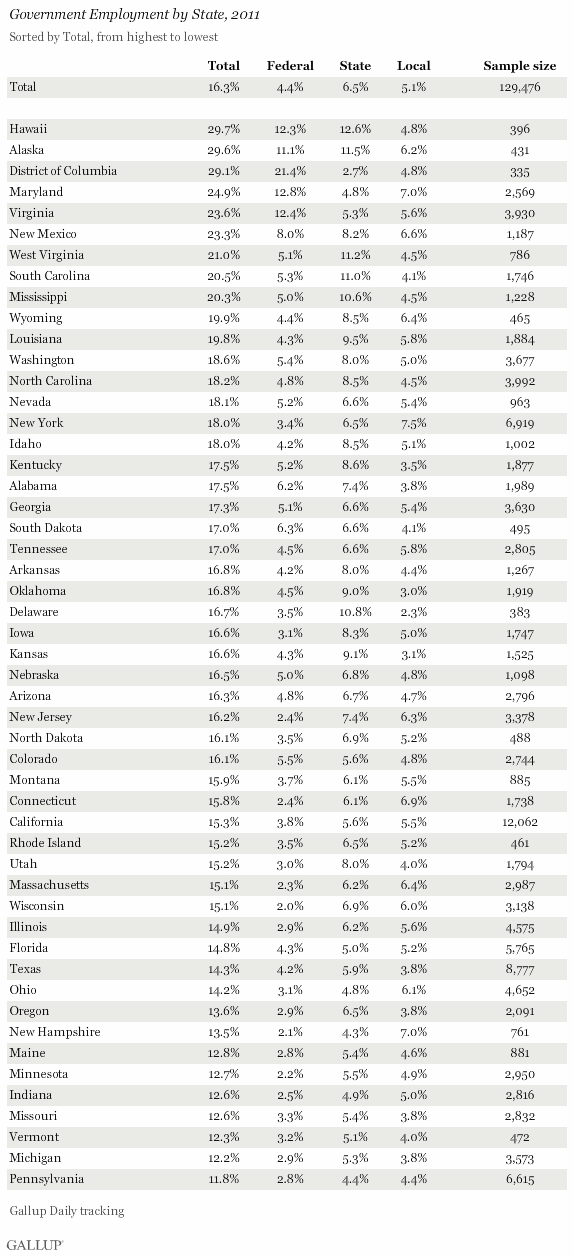WASHINGTON, D.C. -- Nearly 3 out of every 10 workers in Hawaii (29.7%), Alaska (29.6%), and the District of Columbia (29.1%) work for federal, state, or local government, at a time when government employment is declining nationally at all levels. Pennsylvania has the lowest percentage of government workers, at 11.8%.


The findings are from Gallup Daily tracking interviews conducted with 129,476 U.S. workers throughout 2011, and include all workers who say they work for government -- whether federal, state, local, or unspecified. Maryland and Virginia, which neighbor the nation's capital, are fourth and fifth, respectively, in total government employment. Nationwide, the states with above-average levels of government employment are mixed geographically, while, the states with the below-average levels of government employment are all in the Northeast or the Midwest. In no state do fewer than 1 in 10 workers work for government.
Government Employment Declines at All Levels Nationwide
 |
| Explore complete state data > |
Overall, 16.3% of U.S. workers Gallup surveyed in 2011 said they work for government, down from 17.2% in 2010 and 17.3% in 2009. This is consistent with the decline of 280,000 government jobs the U.S. Bureau of Labor Statistics reported for 2011. The overall decline in Gallup's data was distributed equally across federal, state, and local government, with a nationwide decline of 0.3 percentage points at each level.
State government employed the highest percentage of government workers in the U.S. overall in 2011, at 6.5%, followed by local government at 5.1% and the federal government at 4.4%. The remaining 0.3% of government workers did not specify which level of government they worked for. Both state and local government employment have trended downward since 2009, while federal government employment decreased in 2011 after increasing in 2010.

Gallup has also documented declines in total government employment nationwide over the past three years with its Job Creation Index. The Job Creation Index score for government jobs stood at -10 in 2011, with an average of 23% of government workers saying their employer was hiring and 33% saying their employer was letting workers go.
Washington, D.C., Sees Decline in Federal Jobs but Still Leads Nation
Washington, D.C., easily leads in the nation in federal government employment, but the 21.4% of workers who are in federal government jobs is down 4.1 points in 2011 compared with 2010. The neighbors of the nation's capital, Maryland and Virginia, are second and third.
Hawaii and Alaska come in fourth and fifth in federal employment and lead the nation in state employment, helping to explain their high level of government employment overall. New York, New Hampshire, Maryland, Connecticut, and New Mexico have the highest percentages of local government workers.

Federal, state, and local government employment did not change much at the state level. No state saw federal or state employment increase to a statistically significant degree.
For complete data for all states, see page 2.
Implications
At a time when fear of big government is near a record high, Gallup Daily tracking finds federal, state, and local government employment decreasing nationally. Still, government employs 16.3% of U.S. workers and at least 1 in 10 workers in every U.S. state.
Given that the broader U.S. economy has been improving, a key question is whether some of the government jobs that have been lost will come back or to what extent the U.S. may be headed toward an era of smaller government. It is possible that state and local governments' job creation may stabilize as their budgets rebound after the economic crisis.
The federal government of course faces the most negative balance sheet of all. While federal job cuts clearly affect the nation's capital first and foremost, Gallup's state-level data serve as a reminder that government contraction has the potential to affect every state in the nation.
Gallup's "State of the States" series reveals state-by-state differences on political, economic, and well-being measures Gallup tracks each day. New stories based on full-year 2011 data will be released throughout the month of February.
Survey Methods
Results are based on telephone interviews conducted as part of Gallup Daily tracking survey Jan. 1-Dec. 31, 2011, with a random sample of 129,476 working adults, aged 18 and older, living in all 50 U.S. states and the District of Columbia.
For results based on the total sample of national adults, one can say with 95% confidence that the maximum margin of sampling error is ±1 percentage point.
Margins of error for individual states are no greater than ±6 percentage points, and are ±3 percentage points in most states. The margin of error for the District of Columbia is ±7 percentage points.
Interviews are conducted with respondents on landline telephones and cellular phones, with interviews conducted in Spanish for respondents who are primarily Spanish-speaking. Each sample includes a minimum quota of 400 cell phone respondents and 600 landline respondents per 1,000 national adults, with additional minimum quotas among landline respondents by region. Landline telephone numbers are chosen at random among listed telephone numbers. Cell phone numbers are selected using random-digit-dial methods. Landline respondents are chosen at random within each household on the basis of which member had the most recent birthday.
Samples are weighted by gender, age, race, Hispanic ethnicity, education, region, adults in the household, and phone status (cell phone only/landline only/both, cell phone mostly, and having an unlisted landline number). Demographic weighting targets are based on the March 2011 Current Population Survey figures for the aged 18 and older non-institutionalized population living in U.S. telephone households. All reported margins of sampling error include the computed design effects for weighting and sample design.
In addition to sampling error, question wording and practical difficulties in conducting surveys can introduce error or bias into the findings of public opinion polls.
For more details on Gallup's polling methodology, visit www.gallup.com.

